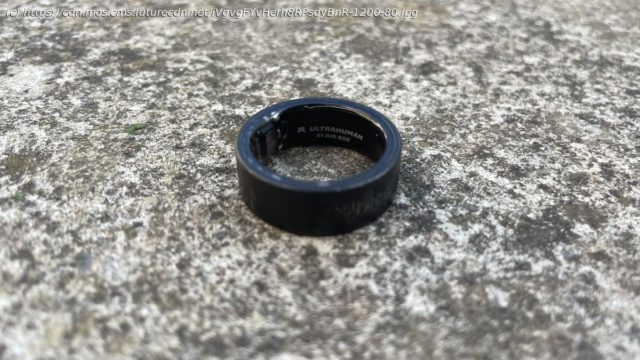A new smart ring is in town, but will you want to wear it?
UltraHuman Ring Air: One minute review
The UltraHuman Ring Air is a smart ring. It’s lined with sensors that sit against your skin and measure your biometric data 24/7. Like other activity trackers, you can view this data whenever you like, but there’s a focus on recovery within the UltraHuman app. I found this incredibly helpful as I’m very active, but often have a tough time regulating my energy levels.
The UltraHuman Ring Air isn’t the only smart ring you can buy. Over the years many startups have started making smart rings, but many encountered problems with funding, legal issues, as well as design challenges – the tiny design doesn’t give you much space to pack in the necessary tech.
The Oura (Gen 3) ring is the top dog at the moment. The brand has been going from strength to strength since its first ring was released back in 2015 – fans allegedly include a bunch of celebs and athletes. UltraHuman entered the market much later in 2022 with its first original UltraHuman Ring. And more rivals are expected soon, like the Circular Ring, and there are even rumours that big tech brands are experimenting with this form factor, too, with a Samsung Galaxy Ring allegedly on the cards.
My biggest issue with smart rings is they’re so different. How do you know whether you’ll enjoy wearing one? Despite thinking the UltraHuman Ring Air looked a little bulky when I first tried it on, it’s incredibly light at only 2.4g, which made it very comfortable to wear, even at night.
The only design flaw is that the ring got scratched after a few weeks of wear. I mostly put this down to lifting weights while wearing it. But I’d expect it to handle a few deadlifts. This will put off those who like their accessories to be pristine because mine definitely lost much of the lovely matte black finish it came with.
Sensor-wise, there’s a lot packed into a small space here. There’s a PPG sensor to monitor circulation, a skin temperature sensor, motion sensors and a bunch of LEDs to track your heart rate and (soon) oxygen saturation. Some key data is missing that you’d find with other high-end wearables, like respiratory rate and VO2 max, but UltraHuman promises both of those are coming in an August update soon.
Because the UltraHuman Ring Air collects and interprets so much data, it’s aimed at those who are serious about training and finding out about how they’re performing and how to optimize in all sorts of areas – whether that’s working out or sleeping. If you don’t care about masses of data, look elsewhere.
Ultimately, we’re wary about recommending a device that’s going to be unlike other wearables you’ve tested. There’s certainly a chance you just won’t like wearing a smart ring. But if you’re willing to try one and you’re looking for genuinely useful insights, it’s a solid option. Read on to find out more about what I thought of the UltraHuman Ring Air. UltraHuman Ring Air: Price and availability
$349 / £280 / about AU$537
Released June, 2023
The UltraHuman Ring Air costs $349 / £280 / about AU$537 and was released in June, 2023.
It’s very difficult to compare this pricing to other wearables. For example, it’s certainly cheaper than the Apple Watch Series 8 at $399 / £419 / AU$629, which collects a similar amount of data. But you’re getting a screen and all sorts of other features with the Apple Watch there. It’s also way more expensive than more budget-friendly trackers that collect large amounts of data but do look a little basic, like the Fitbit Inspire 3 at $99.95 / £84.99 / AU$177.
It makes sense to compare the price to a device like the Whoop 4.0, which may be designed for your wrist but also doesn’t have a screen and is all about that data. But even that’s tricky because it’s based on a subscription model. A 24-month subscription is £16 a month, but you’ll need to pay that upfront as £384. An annual subscription is £19.08 a month, which is £229 upfront.
If this makes you nervous, we get it. But as much as we hate being tied into subscriptions, the benefit is that members can upgrade to the latest generation of hardware when it’s launched.
Of course, the most obvious comparison is the Oura (Gen 3) Ring that costs $299 / about £230 / AU$420. This includes a six-month Oura membership. Once that expires, you’ll need to pay $5.99 / about £4.50 / AU$8 per month to maintain your subscription if you want to keep access to premium features.
The upshot here is that, for the amount of data the UltraHuman Ring Air collects, it’s certainly competitively priced. And appealing if you have subscription fatigue and don’t fancy a membership from Oura or Whoop.
Does that make it good value? Yes and no. You can definitely get similar results from a cheaper device, but this is a lot of fantastic tech packed into a tiny and comfortable form factor. We think the price does make a lot of sense, but it is, as yet, still relatively uncharted territory.
Value score: 4/5UltraHuman Ring Air: SpecificationsUltraHuman Ring Air: Design
Lightweight from 2.
Home
United States
USA — software UltraHuman Ring Air review: it’s lighter than the Oura Ring, but is...






